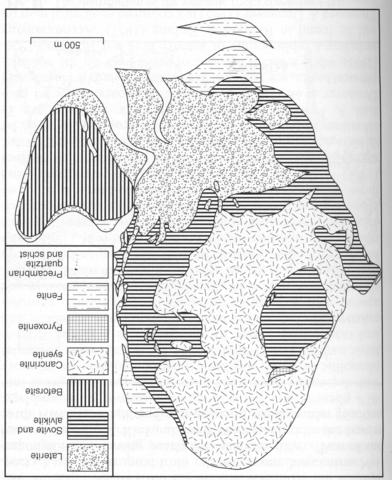stripes
Situated in the Ruinde Mountains of North Kivu the Lueshe complex is emplaced in Precambrian quartzites and garnet, biotite and kyanite schists that are probably part of the Burundian Formation. The oval intrusion is about 2x3 km and consists of cancrinite syenites, carbonatites, minor pyroxenites and a fenite aureole along the eastern margin. Five types of cancrinite syenite have been distinguished (Maravic and Morteani, 1980; Maravic et al., 1989) the distribution of which are depicted on the coloured geological map accompanying the second paper cited. Two types are represented by rocks with trachytic and unorientated textures while the others are characterised by the presence of cancrinite plus either sodic plagioclase, alkali feldspar or calcite. However, there appear to be all gradations between the various types as indicated by modal data and widely differing proportions of albite and microcline while cancrinite, which is close to vishnevite in composition, varies from about 3% to 24% of the rock (Maravic and Morteani, 1980); sodalite is present in some varieties. A moderate amount of calcite occurs in all the syenites but may reach 40%. Biotite is present in most rocks and aegirine in some, while ferrohastingsite is more rare. Accessory minerals include apatite, garnet, opaque phases and strongly zoned pyrochlore and zircon. Small areas of pyroxenite occur both within the syenites and carbonatites. These are banded rocks, darker bands varying in thickness up to 10 cm and consisting of aegirine, biotite and titanite with lighter bands comprising cancrinite, albite and calcite. The syenite is surrounded by a calcite carbonatite which is mineralogically and texturally variable, the coarser sovites carrying 0.5-1 cm diameter calcites in which blebs of dolomite may be seen. Aegirine needles, apatite, pyrochlore and sometimes microcline and amphibole tend to be concentrated in discontinuous layers. Close to the syenite the grain size decreases and xenoliths of syenite may be present, indicating their relative ages, while elsewhere close to contacts biotite and vermiculite are abundant. Silico-sovites occur in part of the complex and consist of approximately equal proportions of calcite and alkali feldspar (40-50%) with lesser amounts of pyroxene, apatite and zircon. A dolomite carbonatite occupies the southeastern part of the complex but the contact with the sovite is not exposed. The principal variety consists of up to 90% dolomite, with acicular eckermannite, apatite and pyrochlore, and some alkali feldspar and biotite; a hematite-bearing variant is dark red. Meyer and Bethune (1958) report the presence of a magnesite carbonatite and give an analysis which indicates that the rock must consist dominantly of that mineral. Maravic and Morteani (1980) were not able to find magnesite. The fenitization has involved country rock quartzites, mica schists and amphibolites and has led to the production of quartz and syenitic fenites with sodic amphiboles, pyroxenes and mica. The chemistry and mineralogy of the fenitization process has been investigated in detail by van Overbeke (1996). Rock analyses will be found in Meyer and Bethune (1958), Maravic and Morteani (1980) and van Overbeke (1996), the last reference including much REE data. Carbon and oxygen isotope data for the sovite are in Pineau and Javoy (1969) and Denaeyer (1970). A detailed study of pyrochlore, in both fresh rocks and laterite, by Wall et al. (1996), which includes many analyses, demonstrated that there are many pyrochlore types in the Lueshe complex. Notable earlier work on pyrochlore is that of van Wambeke (1978) who described kalipyrochlore, of which this is the type locality. Lueshite was described by Safiannikoff (1959) and apatite by Brasseur et al. (1961).
K.-H. Albers, pers. comm., 1999. BELLON, H. and POUCLET, A. 1980. Datations K-Ar de quelques laves du Rift-ouest de l'Afrique Centrale; implications sur l'évolution magmatique et structurale. Geologische Rundschau, 69: 49-62.BRASSEUR, H., HERMAN, P. and HUBAUX, A. 1961. Apatites de l'est du Congo et du Ruanda. Annales de la Société Géologique de Belgique, Liège, 85: 61-85.DENAEYER, M.E. 1970. Rapports isotopiques (O et (C et conditions d'affleurement des carbonatites de l'Afrique centrale. Comptes Rendus Hebdomadaire des Séances de l'Académie des Sciences, Paris, 270D: 2155-8.KAMPUNZU, A.B., KRAMERS, J.D. and MAKUTU, M.N. 1998a. Rb-Sr whole rock ages of the Lueshe, Kirumba and Numbi igneous complexes (Kivu, Democratic Republic of Congo) and the break-up of the Rodinia supercontinent. Journal of African Earth Sciences, 26: 29-36.MARAVIC, H.V, and MORTEANI, G. 1980. Petrology and geochemistry of the carbonatite and syenite complex of Lueshe (N.E. Zaire). Lithos, 13: 159-70.MARAVIC, H.V., MORTEANI, G. and ROETHE, G. 1989. The cancrinite-syenite/carbonatite complex of Lueshe, Kivu/NE-Zaire: petrographic and geochemical studies and its economic significance. Journal of African Earth Sciences, 9: 341-55.MEYER, A. and BETHUNE, P.de 1958. La carbonatite Lueshe (Kivu). Bulletin, Service Géologique, Congo Belge, 8(5): 1-19 and 1-12.PINEAU, F. and JAVOY, M. 1969. Détermination des rapports isotopiques 18O/16O et 13C/12C dans diverses carbonatites, implications génétiques. Comptes Rendus Hebdomadaires des Séances de l'Académie des Sciences. Paris, 269D: 1930-3.SAFIANNIKOFF, A. 1959. Un nouveau minéral de niobium. Bulletin des Séances. Académie Royale des Sciences d'Outre-Mer. Bruxelles, 5: 1251-5.SAFIANNIKOFF, A. 1966. Gisement de pyrochlore de Lueshe. Annales de la Société Géologique de Belgique, 90 (4): B461-86.VAN OVERBEKE, A.-C. 1996. Le complexe à carbonatite et syénite de la Lueshe (N-Kivu, Zaïre): pétrogenèse des roches ignées et caractérisation géochimique des processus métasomatiques (fénitisation). PhD thesis, Université Catholique de Louvain, Belgium. 235 pp plus Appendices.VAN WAMBEKE, L. 1978. Kalipyrochlore, a new mineral of the pyrochlore group. American Mineralogist, 63: 528-30.VERHAEGHE, M. 1963. Inventaire des gisements de calcaires, dolomies et travertins du Kivu, du Rwanda et du Burundi. Ministère des Terres, Mines et Energie, Direction du Service Géologique, Republique du Congo, Mémoire, 3: 1-95.WALL, F., WILLIAMS, C.T. and WOOLLEY, A.R. 1996. Pyrochlore from weathered carbonatite at Lueshe, Zaire. Mineralogical Magazine, 60: 731-50.

